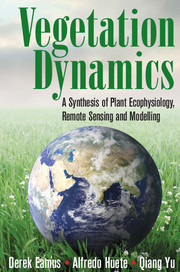Book contents
- Frontmatter
- Contents
- Preface
- Section One Plant Ecophysiology
- Section Two Remote Sensing
- Section Three Modelling
- 8 An Introduction to Modelling in Plant Ecophysiology
- 9 Modelling Radiation Exchange and Energy Balances of Leaves and Canopies
- 10 Modelling Leaf and Canopy Photosynthesis
- 11 Modelling Stomatal and Canopy Conductance
- 12 Modelling Leaf and Canopy Transpiration and the Soil-Plant-Atmosphere Continuum
- 13 Coupling Models of Photosynthesis, Transpiration and Stomatal Conductance and Environmental Controls of Leaf Function
- Section Four Case Studies
- Index
- References
12 - Modelling Leaf and Canopy Transpiration and the Soil-Plant-Atmosphere Continuum
from Section Three - Modelling
Published online by Cambridge University Press: 05 June 2016
- Frontmatter
- Contents
- Preface
- Section One Plant Ecophysiology
- Section Two Remote Sensing
- Section Three Modelling
- 8 An Introduction to Modelling in Plant Ecophysiology
- 9 Modelling Radiation Exchange and Energy Balances of Leaves and Canopies
- 10 Modelling Leaf and Canopy Photosynthesis
- 11 Modelling Stomatal and Canopy Conductance
- 12 Modelling Leaf and Canopy Transpiration and the Soil-Plant-Atmosphere Continuum
- 13 Coupling Models of Photosynthesis, Transpiration and Stomatal Conductance and Environmental Controls of Leaf Function
- Section Four Case Studies
- Index
- References
Summary
Introduction
The concept of the soil-plant-atmosphere continuum (SPAC) was first proposed by Phillip in 1966. In this conceptualisation, water flows from soil to the atmosphere via a plant's hydraulic pathways (Chapter 3). The flow is driven by the gradient of water potential from high to low, arising principally from differences in solute and turgor potentials along the SPAC (Chapter 3).
The biophysical and physiological processes occurring through the soil-plant-atmosphere continuum (SPAC) can be divided into three components: (1) radiation absorption and energy balance; (2) water transfer; and, (3) photosynthesis and physiological regulation of carbon and water fluxes. This chapter focuses on the second process, that is, water transfer, while Chapter 9 deals with the first and Chapter 10 deals with the third process.
There are two significant differences between canopy-scale and leaf-scale transpiration which need to be considered explicitly in models. These are: (a) radiation interception; and, (b) turbulent transfer. It is the shading and multiple layering within canopies that increases the complexity of radiation interception and turbulent transfer. A brief consideration of these is given prior to a more complete description of leaf and canopy transpiration.
Canopy Radiation Exchange
Radiation Interception
Solar radiation is the key input to leaf energy balances and this drives transpiration, in addition to it being the energy source for photosynthesis.
The net radiation balance of a leaf is partitioned into sensible heat by heat conductance and turbulent transfer and into latent heat by transpiration. Because net radiation is a radiation balance between changes in sensible and latent heat exchanges, net radiation represents a steady-state, at any given moment. Leaf temperature, as determined by a leaf's energy balance, influences the biochemical reaction rates of all photosynthetic processes. Leaf temperature determines the leaf's emission of long wave radiation and also determines the saturated water vapour pressure in the sub-stomatal cavity (Chapter 2). Consequently leaf temperature influences stomatal conductance and transpiration.
Turbulent Transfer of Energy and Mass Within and Above a Canopy
CO2 and water vapour pass into and out of stomatal pores, respectively (Chapter 2). The rate of CO2 flux and water vapour transfer are determined by stomatal conductance, boundary layer conductance and differences in CO2 concentration and vapour pressure between the sub-stomatal cavity and ambient air. In these processes there are complex interactions between photosynthesis, stomatal conductance and intercellular CO2 concentration. These are discussed later in this chapter.
- Type
- Chapter
- Information
- Vegetation DynamicsA Synthesis of Plant Ecophysiology, Remote Sensing and Modelling, pp. 296 - 320Publisher: Cambridge University PressPrint publication year: 2016
References
- 1
- Cited by

